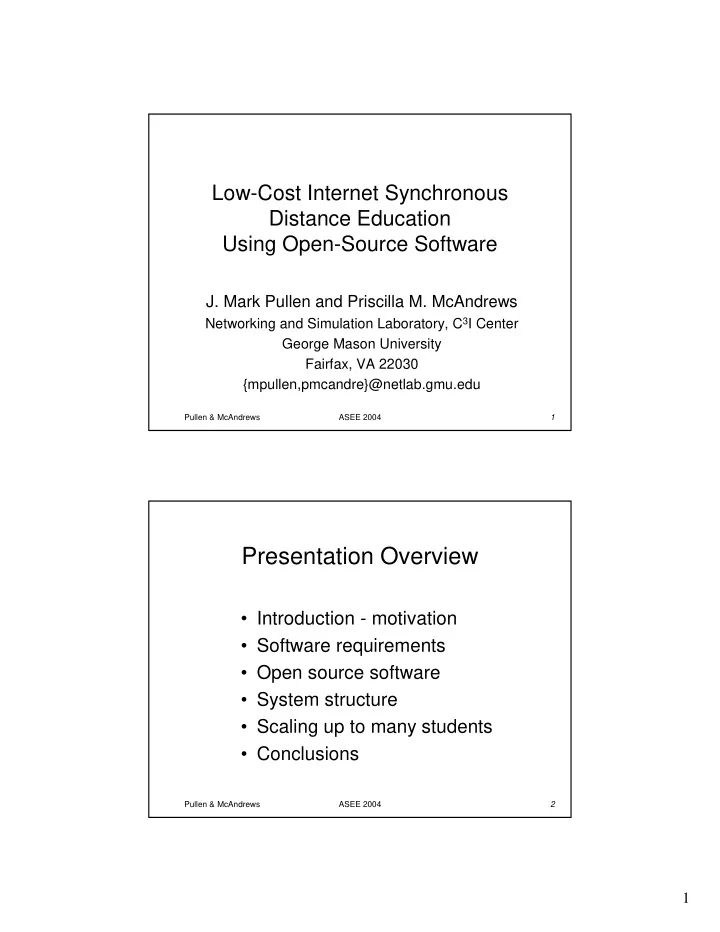

Low-Cost Internet Synchronous Distance Education Using Open-Source Software J. Mark Pullen and Priscilla M. McAndrews Networking and Simulation Laboratory, C 3 I Center George Mason University Fairfax, VA 22030 {mpullen,pmcandre}@netlab.gmu.edu Pullen & McAndrews ASEE 2004 1 Presentation Overview • Introduction - motivation • Software requirements • Open source software • System structure • Scaling up to many students • Conclusions Pullen & McAndrews ASEE 2004 2 1
Motivation • Experience shows instructor-led education is most effective • Synchronous course delivery from live instructors via Internet is practical today – Audiographic delivery is most cost-effective – Best when combined with asynchronous delivery • How to make this affordable? – Simulteaching to in-person and Internet students – Dialup using inexpensive personal computers – Record as it is taught, for missed classes/review – No-cost, open-source software Pullen & McAndrews ASEE 2004 3 Simulteaching Setup Video Clip-On Camera Microphone Workstation Display/Tablet Workstation Keyboard and Mouse Student Instructor Multimedia Multimedia Workstations Workstation Recording of Class Transport Layer Multicast Server Classroom Internet Projector Web and Database Servers one or more logical servers LAN connected to Internet Pullen & McAndrews ASEE 2004 4 2
Simulteaching Software Requirements • Works on inexpensive PC • Works over dialup modem • Quality: well designed, doesn’t break • Simple, robust, easy to use • Scalable to large numbers of students • Works despite firewalls and NATs • Authentication and floor control Pullen & McAndrews ASEE 2004 5 Modular, Open-Source Software User Workstation Recorded Sessions Software Prepared Slides PDF, PostScript, Record/Playback Whiteboard HTML or JPEG (REC/PLAY) (WBD) Audio Send/Receive TLM Client Video Send/Receive (SF) (TLMC) (VIC) TCP or UDP Floor Control/Chat tunnel Server Software Client (FC) MySQL TCP TLM Database connections Record/Playback Apache NEW Control Client Webserver webpages (RC/PC) Pullen & McAndrews ASEE 2004 6 3
Parameters of the Solution • We have determined through experience: – Entire system, from teaching to online delivery, must be designed to be simple and robust, functioning in almost any Internet environment. – Quality, robust software is essential. – System must make online teaching and learning easy • Comparable to teaching with overhead projector – Software must function over low-capacity Internet connections to reach most students. – Use with (not in place of) email, Website, WebCT/Blackboard. Pullen & McAndrews ASEE 2004 7 Software Components • Internet audio: Speak Freely by John Walker • Whiteboard: WBD by U. of Loughborough – Authoring via PDF, for example LaTeX or PowerPoint • Internet video: VIC by Lawrence Berkeley Labs, U. of Southern California and U. College London • Record/Playback by GMU NETLAB • Floor Control by GMU NETLAB • Transport Layer Multicast (live) server and client by GMU NETLAB • Apache Webserver by Apache Digital • MySQL database by MySQL AB • Chat: browser-based phpMyChat (also MySQL) Pullen & McAndrews ASEE 2004 8 4
System Structure • Multi-platform target architecture – first release client is Windows-only • Thirteen building blocks – all communicate via Internet Protocol – allows flexible configuration • Generally, one server per classroom – peer-to-peer client supports range of modes – lecture, seminar, conferencing – two-way audio (also text questions and chat) Pullen & McAndrews ASEE 2004 9 Assembled Tools - Teaching Pullen & McAndrews ASEE 2004 10 5
Talking Head Video Interface (NEW also supports downloaded video clips) Pullen & McAndrews ASEE 2004 11 Scaling Up Course Management • Started with one course per semester – Ran it on desktop computer • Now have twelve per semester – Need a real server – More than that: webpages and a database • Learned how to scale up – And stay cost-effective Pullen & McAndrews ASEE 2004 12 6
Scaling Issues • Worldwide or regional access? • Technologies used must be scalable • System design and procedures too • Webpages make system easy to use – Students are no longer “early adopters” • Dialup modem for quality of service • Not all students want online access – But nearly all of them want playback Pullen & McAndrews ASEE 2004 13 NEW Webpage Functions • User authentication • Download/install software • Connect to live class – Spoken input and video optional • Connect with a recorder for teaching • Class chat room • Review: playback, teaching slides • Instructor email to class • Upload/download slides and recordings • Database and server administration Pullen & McAndrews ASEE 2004 14 7
NEW Welcome Webpage Pullen & McAndrews ASEE 2004 15 Institutional Issues • Do this to make education more accessible – Probably no cost savings to university – But it reaches an underserved group • Even progressive faculty members resist new media – Simulteaching helps (known paradigm) • Online teaching requires more institutional support – Save on classrooms; pay for assistants Pullen & McAndrews ASEE 2004 16 8
Instructors Must Be Reminded • The online student does not benefit when you point your hand at the screen- use the WBD arrow! • The online student can’t hear other student questions from the back row – repeat the question! Pullen & McAndrews ASEE 2004 17 Conclusions • Synchronous online teaching with open source software is popular with our students – And the faculty are growing to like it too • Software must be simple to use and scalable • Requires some extra support • Inexpensive computers and free software allow cost break-even or better – While reaching a new group of students! Pullen & McAndrews ASEE 2004 18 9
For more information: http://netlab.gmu.edu/NEW Pullen & McAndrews ASEE 2004 19 10
Recommend
More recommend